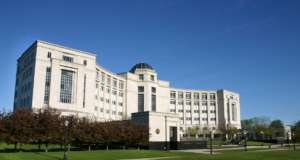U.S. Supreme Court sides with student in free speech case
3 min read
The U.S. Supreme Court ruled in favor of free speech rights for students outside of the classroom in a decision Wednesday.
The court sided with former Mahanoy Area High School student and cheerleader Brandi Levy in the case, formally known as Mahanoy Area School District v B.L., with a 8-1 decision in her favor. Mahanoy Area High School is located in Pennsylvania.
Levy, upset that she had not made her school’s varsity cheer team, posted on the social media site Snapchat a simple message with explicit language expressing her frustration.
The message was captured by a classmate and was eventually presented to school officials, who decided to suspend Levy from the junior varsity cheer team for a year.
The high court found the school violated Levy’s First Amendment right to freedom of speech since her comments took place outside of school hours and off school grounds.
Justice Stephen Breyer wrote the majority opinion. He was joined by Chief Justice John Roberts and Justices Samuel Alito, Sonia Sotomayor, Elena Kagan, Neil Gorsuch, Brett Kavanaugh and Amy Coney Barrett.
In the opinion, Breyer discussed the school’s overreach of power by punishing Levy for comments which had little effect on the school itself. He also addressed the importance of protecting vulgar language when it does not have a specific negative effect on the school community.
“It might be tempting to dismiss B. L.’s words as unworthy of the robust First Amendment protections discussed herein,” Breyer said. “But sometimes it is necessary to protect the superfluous in order to preserve the necessary.”
Breyer also made clear that although the court reached the same conclusion as the third circuit court’s findings, its reasoning differs significantly.
Alito wrote a concurring opinion, joined by Gorsuch, in which he explains it is beyond the jurisdiction of the school to punish students outside of the classroom, even if the speech would not be protected while on school grounds or at school sponsored events.
“There are parents who would not have been pleased with B. L.’s language and gesture, but whatever B. L.’s parents thought about what she did, it is not reasonable to infer that they gave the school the authority to regulate her choice of language when she was off school premises and not engaged in any school activity,” said Alito.
The lone dissent came from Justice Clarence Thomas, who argued precedent as it came to the school’s authority of loco parentis, or in the place of a parent, does not support the majority opinion. He also argued that the opinion failed to show why this situation would cause a break in precedent.
“The majority fails to consider whether schools often will have more authority, not less, to discipline students who transmit speech through social media,” said Thomas. “Because off-campus speech made through social media can be received on campus (and can spread rapidly to countless people), it often will have a greater proximate tendency to harm the school environment than will an off-campus in-person conversation.”
The Mahanoy Area School District praised the court’s rejection of the Third Circuit’s findings.
“The School District unanimously won the issue upon which it sought Supreme Court review: all 9 Justices rejected the Third Circuit’s conclusion that school districts lack authority to regulate off-campus speech,” the district said.
The school district also expressed disappointment in losing the overall case but reiterated their pleasure with the court identifying the instances in which the school may punish off-campus speech.
The American Civil Liberties Union argued for Levy in this case. ACLU National Legal Director David Cole expressed satisfaction with the decision.
“The school in this case asked the court to allow it to punish speech that it considered ‘disruptive,’ regardless of where it occurs,” said Cole. “The message from this ruling is clear — free speech is for everyone, and that includes public school students.”
Levy, who is now a college student, praised the court’s decision.
“I never could have imagined that one simple snap would turn into a Supreme Court case, but I’m proud that my family and I advocated for the rights of millions of public school students,” said Levy.
This article was originally posted on U.S. Supreme Court sides with student in free speech case







